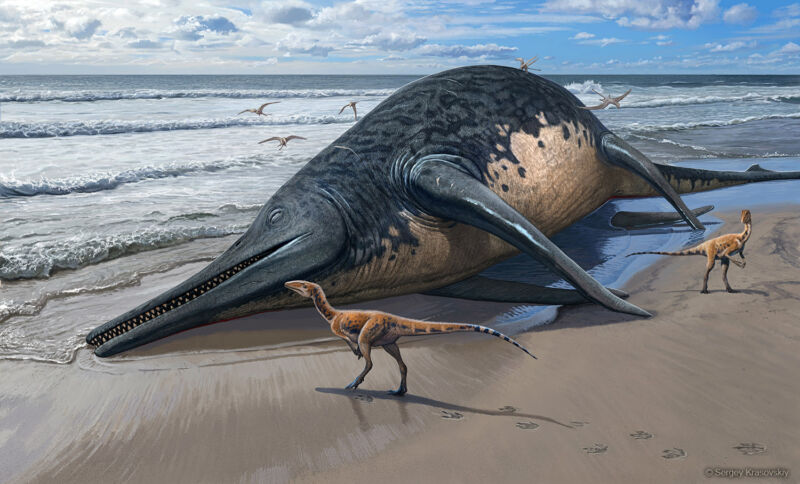Blue whales are believed to be the largest creatures that have ever lived on Earth. Their maximum length is nearly 30 meters and their weight is nearly 200 tons. They are the undisputed heavyweight champion in the history of the animal world.
Now, a team of British paleontologists digging on a beach in Somerset, England, have discovered the remains of an ichthyosaur, a marine reptile that could have given some competition to whales. Dean Lomax, a paleontologist at the University of Manchester who led the study, said it was remarkable that huge ichthyosaurs the size of blue whales swam in the oceans around Britain during the Triassic period.
huge jawbone
Ichthyosaurs have been found in the oceans for most of the Mesozoic Era, appearing as early as 250 million years ago. They have four limbs that look like paddles, with a vertical tail fin extending downward in most species, and often look like large reptilian dolphins with elongated, narrow jaws filled with teeth. Some of them are really big.The largest ichthyosaur skeleton so far was found in British Columbia, Canada. It is 21 meters long and belongs to a particularly huge ichthyosaur named Xikang Songlong. But it seems they may get bigger.
In Somerset, Lomax’s team discovered a long bone, a long, curved bone found at the top of the jaw, behind the teeth, in all reptiles. This bone is 2.3 meters longer than the upper bone found. Xikang Songlong Bones, it’s 25% bigger. Through simple scaling and assuming the same body proportions, the Lomax team estimated the size of the newly discovered ichthyosaur to be between 22 and 26 meters, which would make it the largest marine reptile ever recorded. But there’s one more thing.
When examining the upper horn, the team found no signs of the external elementary system (EFS), a band of tissue present in the outermost cortex of the bone. Its formation signals a slowdown in bone growth and indicates skeletal maturation. In other words, the giant ichthyosaur was probably young and still growing when it died.
correct the past
In 1846, five large bones were discovered on the Oyster Cliffs near Bristol in southwestern England. Excavated from the Upper Triassic rock formations, they are known as dinosaur limb skeletons and are on display at Bristol Museum, one of which was destroyed by bombing during the Second World War.
But in 2005, Peter M. Galton, a British paleontologist then working at the University of Bridgeport, noticed something strange about a bone in the Oyster Cliffs wreckage. He described it as an unusual hole and suggested it was a nutrient channel. Later studies generally attributed the bones to dinosaurs, but noted some unusual microstructures that were difficult to explain.
According to Lomax, all this confusion stems from the fact that the Oster Cliff bones do not belong to the dinosaur and are not part of a limb. He noted that the morphology, shape and microstructure of the vegetative pores were consistent with the ichthyosaurs found in Somerset. The difference is that the Oster Cliff skeleton shows signs of EFS – mature skeleton. If Lomax is right and they are indeed part ichthyosaur, then they are adults.
Using the same scaling technique as the Somerset Longwhale, Lomax estimated the adult to be over 30 meters long, slightly larger than the largest confirmed blue whale.
about to extinct
Late Triassic ichthyosaurs may have reached the limits of known vertebrate biology in size. Marcello Perillo, a member of the Lomax team who examined the skeleton’s internal structure, said much about these giants remains shrouded in mystery, but one fossil at a time, we will be able to unlock their secrets.
However, the mysterious beast didn’t last long. The horn bones found in Somerset, buried in a layer of seismite and tsunami rocks, show the beginning of the end-Triassic mass extinction, one of the five mass extinctions in Earth’s history.this Severn fishAs Lomax and his team named the species, it may have reached incredible size but was quickly wiped out.
However, the mass extinction at the end of the Triassic was not the end for all ichthyosaurs. They survived but never reached a similar size again. They faced competition from more agile, faster-swimming plesiosaurs and sharks, which likely competed for the same habitat and food sources. The last known ichthyosaurs became extinct about 90 million years ago.
PLOS ONE, 2024.
#largest #marine #reptile #discovered #comparable #size #blue #whale
Image Source : arstechnica.com
